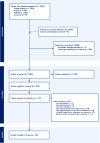Heart failure outcomes in Sub-Saharan Africa: a scoping review of recent studies conducted after the 2022 AHA/ACC/HFSA guideline release
- PMID: 40264003
- PMCID: PMC12012955
- DOI: 10.1186/s12872-025-04756-y
Heart failure outcomes in Sub-Saharan Africa: a scoping review of recent studies conducted after the 2022 AHA/ACC/HFSA guideline release
Abstract
Background: Heart failure (HF) in Sub-Saharan Africa (SSA) presents unique challenges, with high prevalence and distinct epidemiological features compared to high-income settings. Despite its burden, recent comprehensive data are lacking, especially amidst recent 2022 AHA/ACC/HFSA guideline release. This scoping review aims to map the literature on HF in SSA, focusing on aetiologies, structural abnormalities, management practices, and outcomes to identify research gaps and inform clinical practice.
Methods: Studies from 2022-2024 published in English or French were included, covering adult patients > 18 years, all study designs except case reports. Studies not reporting any outcomes or focusing solely on one HF subtype were excluded. Literature from all SSA countries was searched using a FACET approach in databases including PubMed, Google Scholar, Cochrane and Scopus.
Results: Ten studies, evaluating 2039 patients, were analysed. Dilated cardiomyopathy (DCM), and Hypertensive cardiomyopathy (HCM) emerged as prominent aetiologies. Rheumatic heart disease was reported in only four studies. Common issues included high rates of electrolyte disturbances and anemia, which influenced patient outcomes. Guideline adherence exhibited significant deficiencies, notably with a suboptimal prescription rate of SGLT2 inhibitors (8.3-24.7%). Mortality rates ranged from 3.7% to 19%, linked to factors like low blood pressure and electrolyte imbalances. Hospital stays were variable but significant rehospitalization were common within 8-15 days post discharge and associated with non-compliance and lifestyle factors.
Conclusion: HCM and DCM are prevalent heart failure aetiologies in SSA. Longitudinal studies are recommended to contextualise aetiological diagnosis and validate prognostic tools amidst limited resources. Enhanced guideline adherence, hypertension control and efficient post-discharge care are essential to reduce morbidity and mortality.
Keywords: Aetiologies; Guideline adherence; Heart failure; Mortality rates; Sub-Saharan Africa.
© 2025. The Author(s).
Conflict of interest statement
Declarations. Ethics approval and consent to participate: Not applicable. Consent for publication: Not applicable. Competing interests: The authors declare no competing interests.
Figures
Similar articles
-
Heart failure in patients with coronary heart disease: Prevalence, characteristics and guideline implementation - Results from the German EuroAspire IV cohort.BMC Cardiovasc Disord. 2017 May 5;17(1):108. doi: 10.1186/s12872-017-0543-0. BMC Cardiovasc Disord. 2017. PMID: 28476146 Free PMC article.
-
Increases in statin eligibility to reduce cardiovascular risk according to the 2013 ACC/AHA cholesterol guidelines in the Africa Middle East region: a sub-analysis of the Africa Middle East Cardiovascular Epidemiological (ACE) study.BMC Cardiovasc Disord. 2019 Mar 15;19(1):61. doi: 10.1186/s12872-019-1034-2. BMC Cardiovasc Disord. 2019. PMID: 30876390 Free PMC article.
-
Guideline-Appropriate Care and In-Hospital Outcomes in Patients With Heart Failure in Teaching and Nonteaching Hospitals: Findings From Get With The Guidelines-Heart Failure.Circ Cardiovasc Qual Outcomes. 2016 Nov;9(6):757-766. doi: 10.1161/CIRCOUTCOMES.115.002542. Epub 2016 Oct 25. Circ Cardiovasc Qual Outcomes. 2016. PMID: 27780849
-
Reasons for poor blood pressure control in Eastern Sub-Saharan Africa: looking into 4P's (primary care, professional, patient, and public health policy) for improving blood pressure control: a scoping review.BMC Cardiovasc Disord. 2021 Mar 4;21(1):123. doi: 10.1186/s12872-021-01934-6. BMC Cardiovasc Disord. 2021. PMID: 33663387 Free PMC article.
-
Anaemia and iron deficiency in heart failure: epidemiological gaps, diagnostic challenges and therapeutic barriers in sub-Saharan Africa.Cardiovasc J Afr. 2017 Sep/Oct;28(5):331-337. doi: 10.5830/CVJA-2017-001. Cardiovasc J Afr. 2017. PMID: 29144533 Free PMC article. Review.
Cited by
-
Generating Important Insights into the Spectrum and Outcomes of Acute Heart Failure Across the African Continent: The Sub-Saharan Africa Survey of Heart Failure (THESUS-HF II).Glob Heart. 2025 Jul 23;20(1):64. doi: 10.5334/gh.1449. eCollection 2025. Glob Heart. 2025. PMID: 40718754 Free PMC article.
References
-
- Gtif I, Bouzid F, Charfeddine S, Abid L, Kharrat N. Heart failure disease: An African perspective. Arch Cardiovasc Dis. 2021;114:680–90. - PubMed
-
- Savarese G, Becher PM, Lund LH, Seferovic P, Rosano GMC, Coats AJS. Global burden of heart failure: a comprehensive and updated review of epidemiology. Cardiovasc Res. 2023;118:3272–87. - PubMed
-
- Dzudie A, Hongieh Abanda M, Nkoke C, Barche B, Damasceno A, Edwards C, et al. Clinical characteristics and outcomes of black African heart failure patients with preserved, mid-range, and reduced ejection fraction: a post hoc analysis of the THESUS-HF registry. ESC Heart Fail. 2021;8:238–49.
-
- Heidenreich PA, Bozkurt B, Aguilar D, Allen LA, Byun JJ, Colvin MM, et al. 2022 AHA/ACC/HFSA Guideline for the Management of Heart Failure: A Report of the American College of Cardiology/American Heart Association Joint Committee on Clinical Practice Guidelines. J Am Coll Cardiol. 2022;79:e263-421. - PubMed
Publication types
MeSH terms
LinkOut - more resources
Full Text Sources
Medical
Research Materials
Miscellaneous



